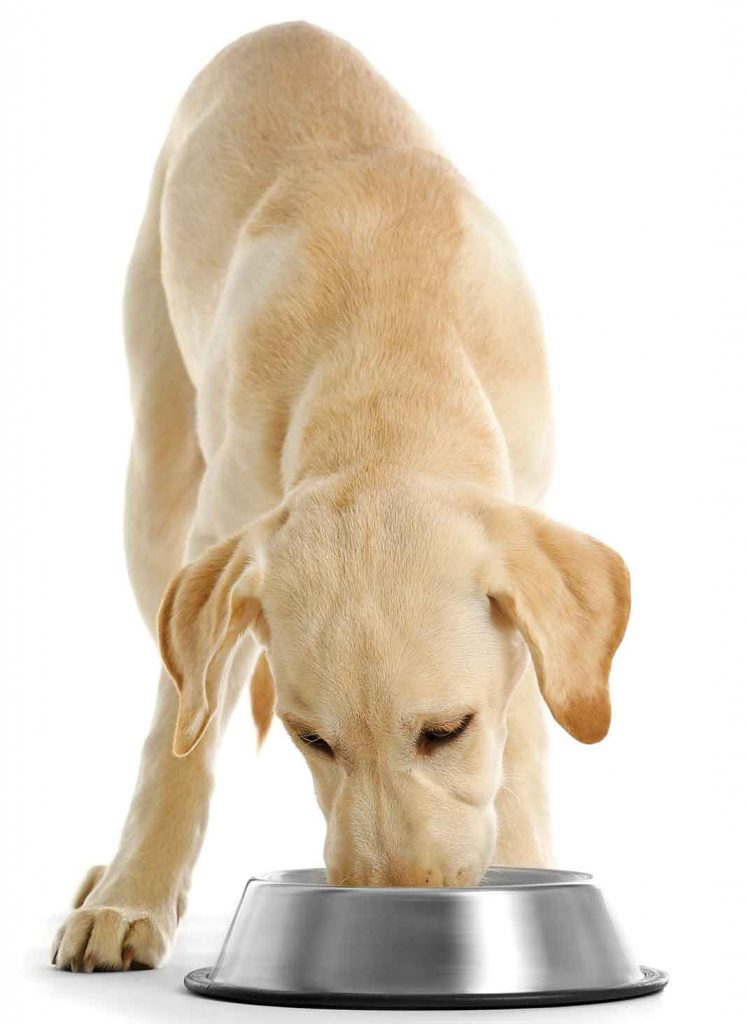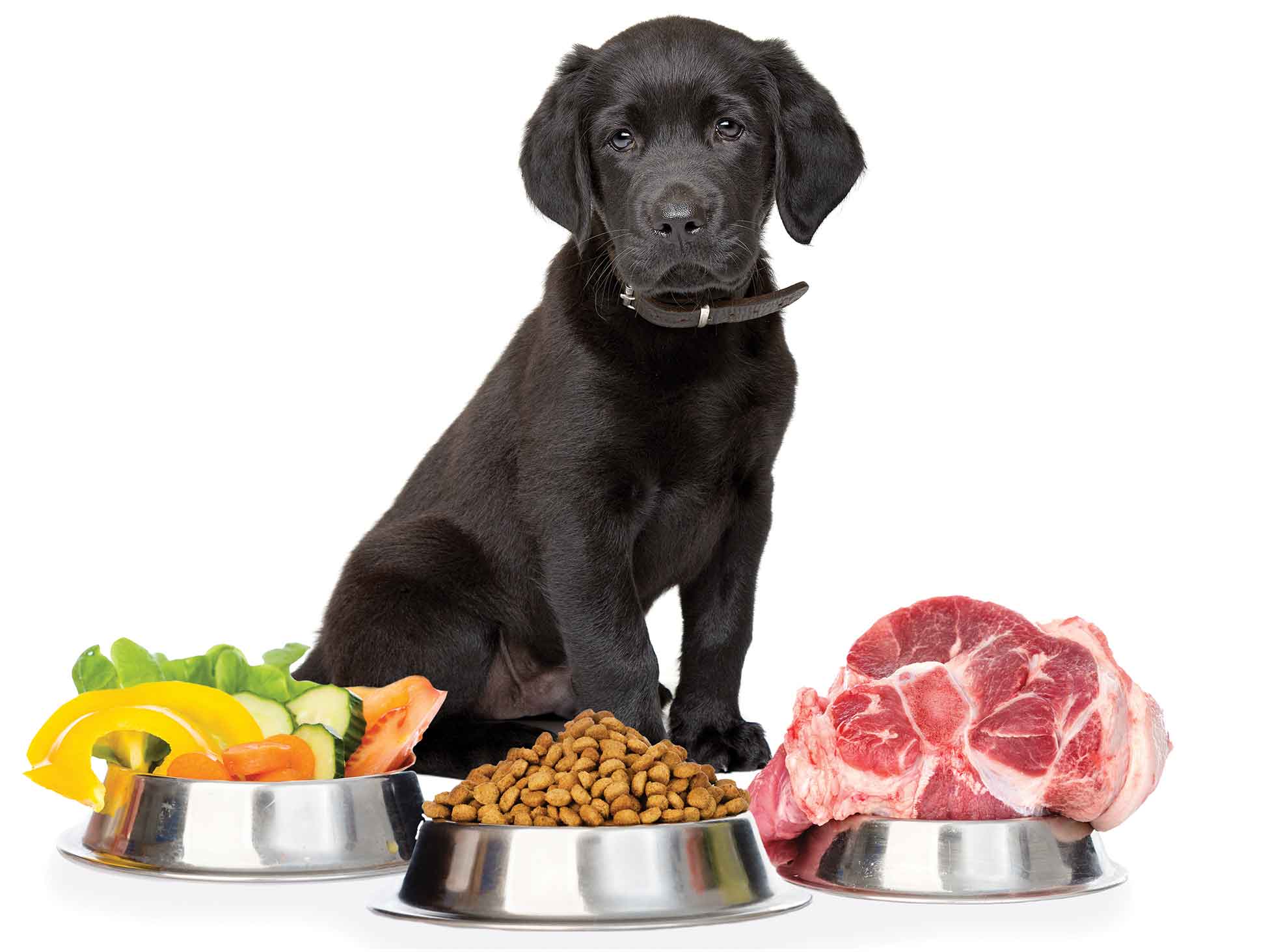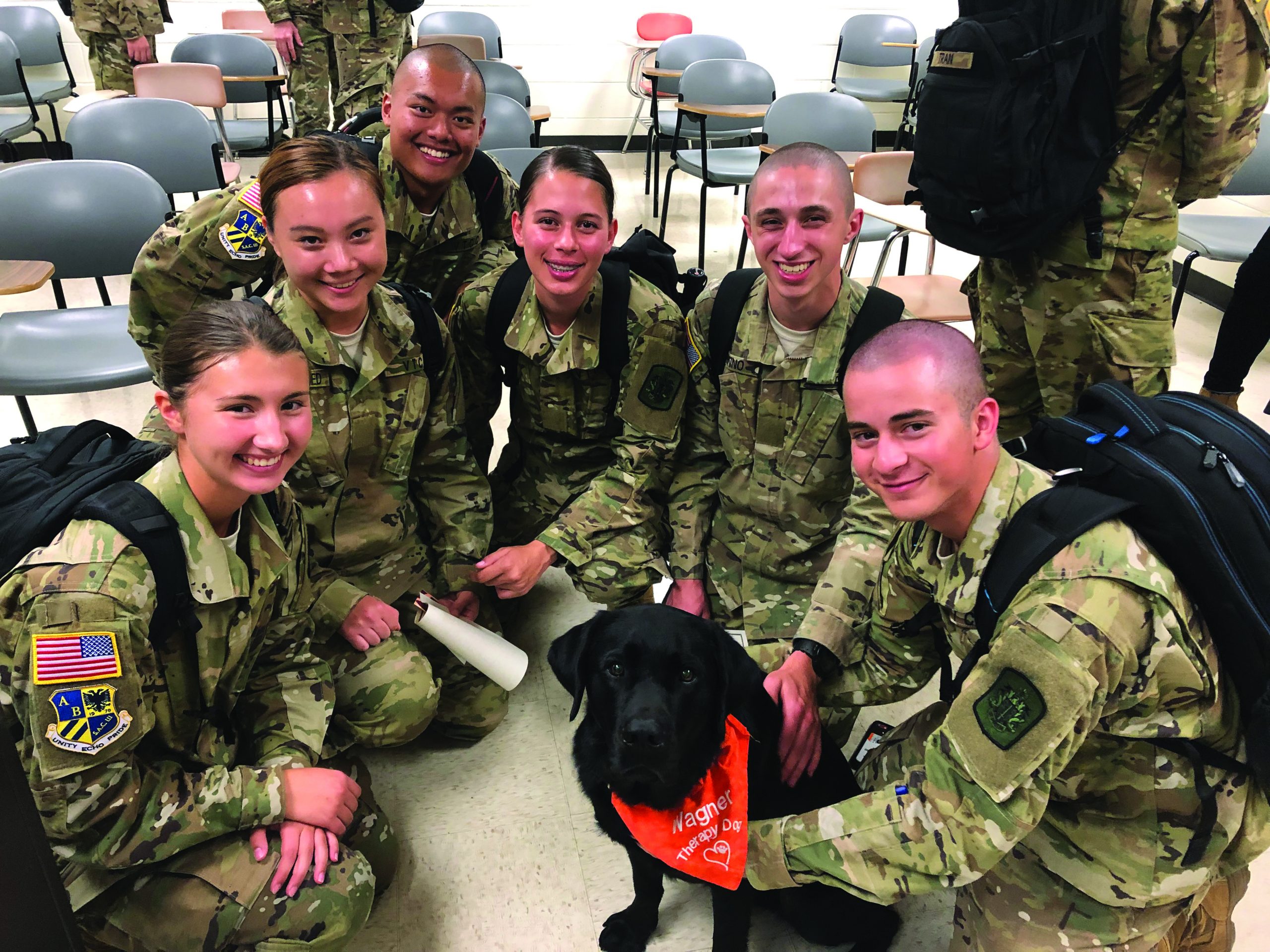Not just any food will do
by Laura Card
Having a new puppy in the house can be a magical time. The early days of puppy ownership are filled with getting to know your pup’s personality, helping him learn the rules, and watching nonstop cycles of playing and napping. Toys will be bought, collars picked out, and dog beds acquired. But in addition to all those inconsequential choices, pet owners will need to make a decision with long-lasting health implications: what to feed their growing pup.
Feeding a puppy the right balance of nutrients, vitamins, minerals, and calories is key to their long-term health, says Dr. Jill Cline, site director for the Eukanuba and Royal Canin Pet Health and Nutrition Center.
For large-breed puppies like Labs, Dr. Cline recommends feeding a specially formulated large-breed puppy kibble that contains all the right elements to let puppies grow at the right rate. “What defines large-breed puppy food, compared to other puppy foods, is that the vitamin and mineral content is adjusted for dogs who are growing slower and should have slower bone growth,” says Dr. Cline.
The Right Combination
A balanced puppy kibble formula will contain protein, fats, carbohydrates, vitamins, and minerals, each in the quantities needed for a pup’s unique nutritional needs.
Proteins provide the amino acids necessary to build and repair muscles and tissues, and puppies generally need a higher amount of protein in their diet than adult dogs do. Common sources of animal proteins include chicken, beef, or turkey; but a combination of meat and vegetables provides the most well-balanced and easily digestible proteins.
Fats supply energy and flavor, and growing puppies need fat in their diet to help their bodies to properly develop. Fatty acids help your Lab to have healthy skin and a shiny coat, and they also play a role in proper brain development and the growth of strong bones. Fats can also help your pup’s body absorb certain nutrients more effectively. Fish oil, vegetable oil, and soybean oil are often used to add fat to puppy food.
Carbohydrates provide an additional source of energy for your pup. Rice, corn, barley, and oats all provide digestible carbohydrates that enzymes can break down into glucose to fuel the body’s cells. Whole grains, such as corn, brown rice, barley, oatmeal, and whole wheat, pack more nutrition into fewer calories than refined grains, such as white rice and flour. In addition to grains, fruits and vegetables provide healthy carbohydrates. Many grains provide other vitamins, minerals, and antioxidants in addition to carbohydrates.
Vitamins and minerals play a crucial role in your Lab’s growth. Vitamins perform a number of vital functions and are involved in vision, metabolic processes, healthy bone growth, and hormone regulation. Antioxidants also help strengthen the immune system.
Your growing puppy also needs a constant source of clean, fresh water to stay hydrated.
As a puppy grows, his caloric and nutritional needs will change over time. Most puppies are eating kibble and nearly fully weaned by the age of eight weeks. Very young puppies need more calories per pound than adult dogs, and older pups need fewer calories per pound than younger puppies. But how much kibble is the right amount?
Instead of focusing on how much weight your puppy is gaining each day, you can use body condition scoring to assess whether your pup is getting too much – or too little – food. A body condition score relies on a visual inspection and uses a nine-point rating system, with obesity at nine and emaciation at one. A healthy weight would be indicated by an abdominal tuck when viewed from the side. Dogs should also have observable waist, but no protruding hip bones.
“Puppies should retain an hourglass shape from above,” Dr. Cline says. “Adult dogs that are performance dogs should have a score of 3.5 to 4.5. It is okay to apply the same nine-point scale to puppies. They get skinny and expand in growth spurts.”
What Can Go Wrong
Once you’ve selected your large-breed puppy kibble, Dr. Cline says it is important not to add supplements – feed only kibble. “The problem we see with combining kibble that has been designed for a specific reason with supplemental food is that the kibble is designed to be the sole source of nutrition for that dog.” An imbalance in nutrients caused by supplemental feeding can lead to a variety of problems down the road. For example, “If [the combined diet] has more phosphorus than calcium, you have bones that don’t adequately calcify and become strong,” Dr. Cline says. “Too many omega-3 fatty acids can cause soft-tissue damage.”
Too much food is another problem that can sneak up on new pet owners. Overfeeding a puppy can affect his health for the rest of his life. While many owners feel the urge to encourage their pups to be roly-poly butterballs, overfeeding as a puppy increases the number of fat cells the body must manage in adulthood. “People think fat puppies are cute puppies; but dogs are like toddlers, and they create all of their fat cells that they’ll have for the rest of their lives in their first few months of life. Labrador puppies can be round balls, but that sets them up to have to manage their weight for the rest of their lives,” says Dr. Cline.
Some pet owners may assume that feeding a puppy smaller amounts of adult dog food is an acceptable choice. Not so, says Dr. Cline. “It has been a concern in the past when people feed adult food only. We have seen dogs grow too fast, and there are long-term and short-term effects of that,” says Dr. Cline. “Large-breed puppy foods are designed to provide appropriate amounts of calcium and phosphorous, as well as the right amount of calories, so the growth rate is appropriate for their size.”
Some owners may deliberately overfeed their pups in an attempt to encourage their puppy to grow as big as possible as fast as possible, but this also comes with many risks. “Optimal growth in large-breed or giant-breed dogs is very different than maximum growth,” says Dr. Karen Becker of Mercola’s Healthy Pets. “Overfeeding a puppy during the period of rapid growth after weaning leads to skeletal problems. When a puppy’s body gets too big too fast, or it gains a lot of weight, it puts stress on the developing skeleton. Rapid bone growth can result in structural defects in the bones, which means it’s even more difficult for the skeleton to bear the puppy’s body weight.”
“The goal for large- and giant-breed puppies should be controlled growth, not overgrowth,” Dr. Becker says. “The size a dog grows to is primarily the result of genetics. But the time it takes a dog to reach a full adult size must be controlled by the right types of nutrition.”
When puppies are fed only adult food or are deliberately overfed in order to encourage them to grow quickly, they are at risk of developing bone disorders such as panosteitis, hypertrophic osteodystrophy (HOD), and osteochondritis dissecans (OCD).
“Panosteitis happens in the long bones, when they’re rapidly growing,” says Dr. Cline. Pano causes inflammation of the lining around the bone and leads to pain and lameness in varying legs. A diet too high in calories can be the culprit here.
Oversupplementation of vitamins and nutrients as well as a lack of vitamin C can lead to hypertrophic osteodystrophy, which also presents as pain and lameness. “Like pano, HOD is very painful. Sometimes you’ll see swelling around some of the joints,” says Dr. Cline. Other symptoms may include loss of appetite, depression, and, in severe cases, bone deformities.
One skeletal disorder that is known to plague Labradors more than other breeds is osteochondritis dissecans. OCD results in non-specific lameness and pain, and the condition can be worsened if the pup is over-exercised. Treatment may require surgery to repair damage to joint cartilage, and strict rest and medication may also be necessary.
To decrease the likelihood of your puppy developing skeletal disorders, “Feed to body condition score, and don’t supplement,” says Dr. Cline. “Feed large-breed dogs a size- and breed-specific diet built just for them. Feed them based on body condition score, which is available on the Internet. Don’t intensely exercise them while they’re growing. And don’t supplement.” For more information on body condition scoring, visit https://www.royalcanin.com/ca/en_ca/dogs/weight-management/healthy-shape.
Dogs are considered adult or full-grown when they’ve reached about 80 percent of their projected adult weight. For large-breed puppies like Labs, physical maturity happens at about 18 to 24 months of age, and at that point, they can safely be switched to a high-quality adult dog food.
For more information on canine nutrition, training, and more, visit eukanubasportingdog.com.







